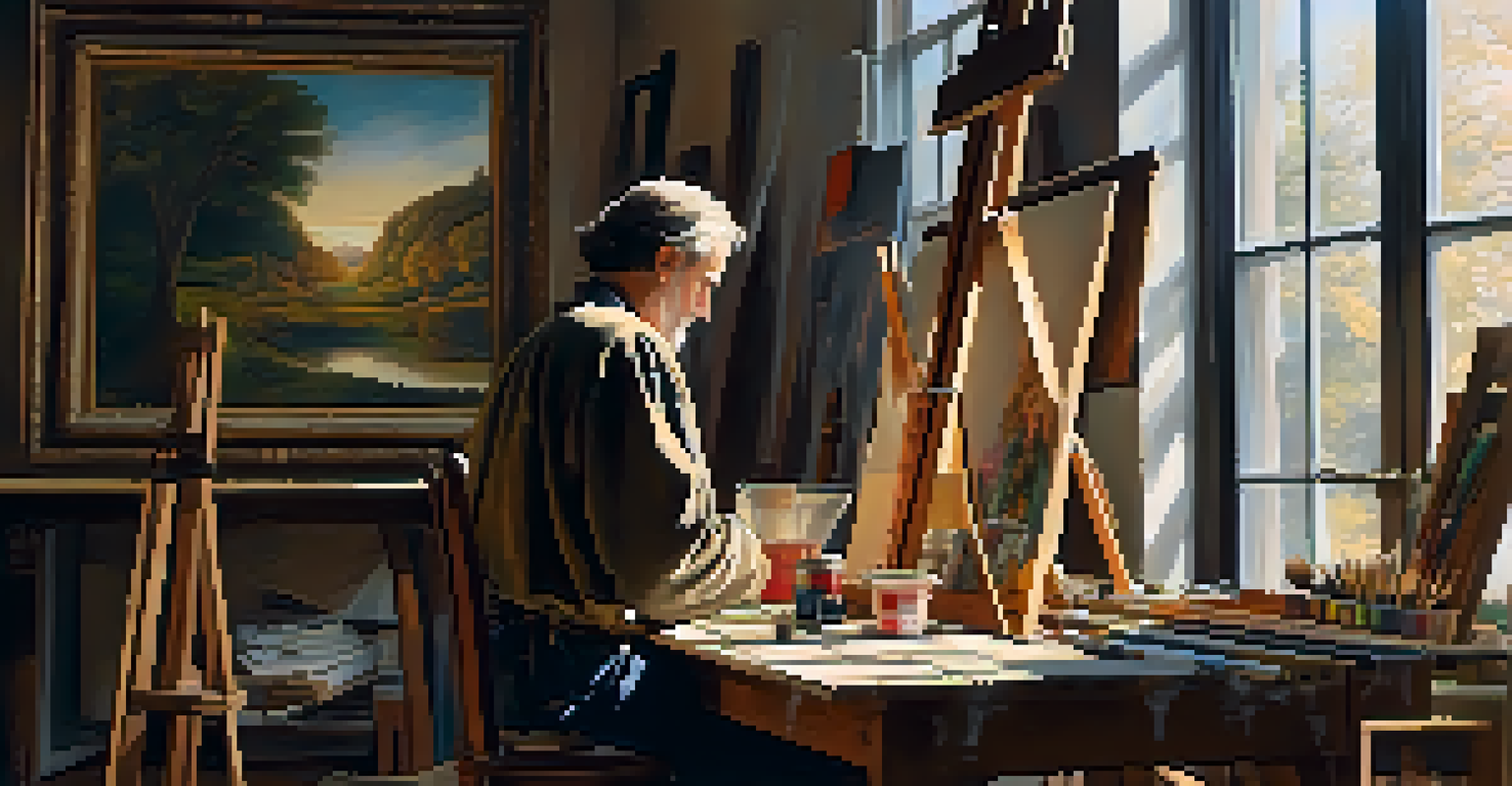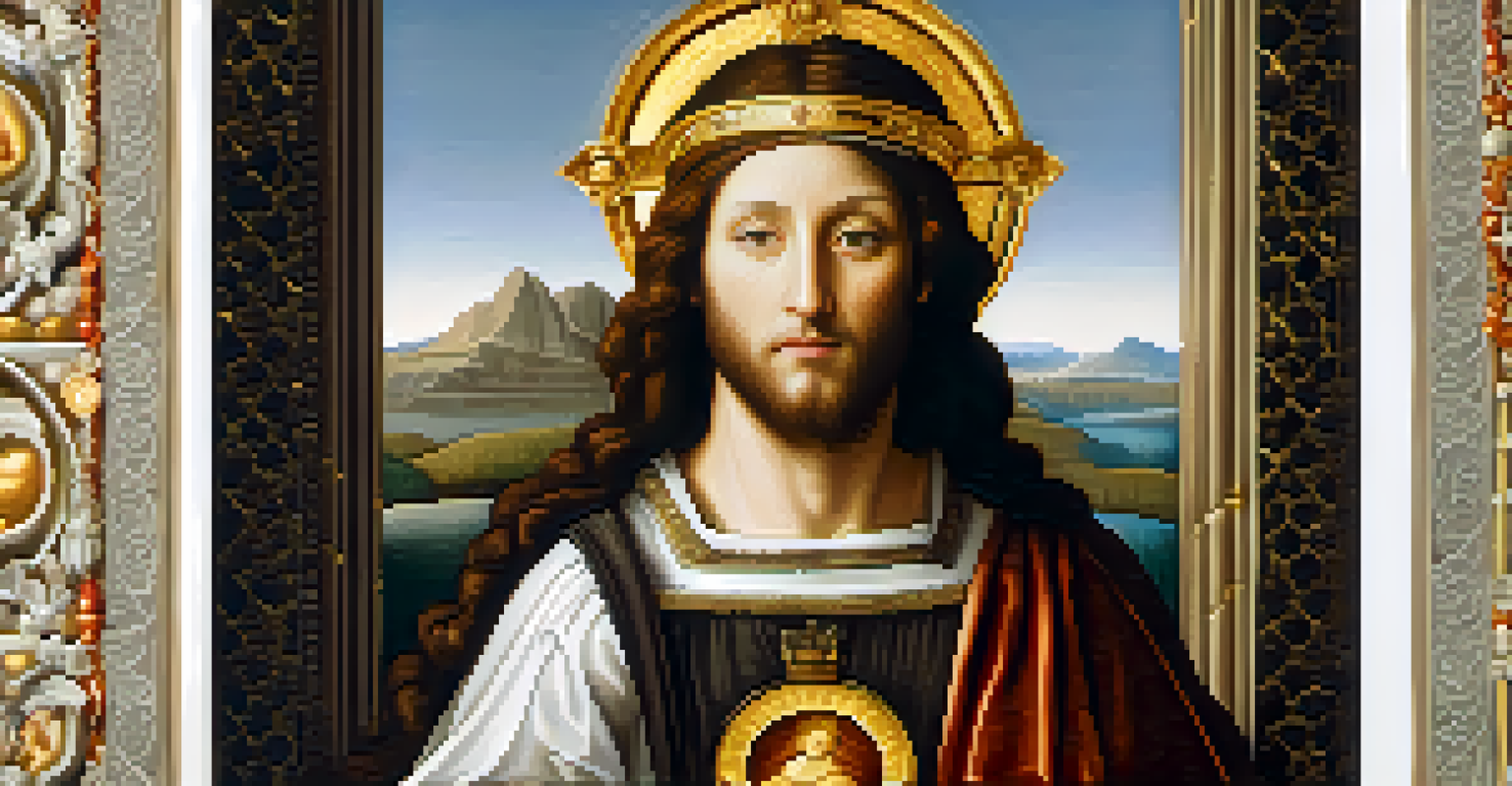Decoding Religious Symbols in Renaissance Paintings

Understanding the Renaissance Context and Its Art
The Renaissance, spanning the 14th to the 17th century, was a time of great cultural rebirth in Europe. This period saw a renewed interest in classical ideas and humanism, which greatly influenced art. Artists began to incorporate religious themes into their work, reflecting the era's spiritual and intellectual currents. Understanding this context is crucial for decoding the symbols embedded in their paintings.
Art is a reflection of society, and to understand it, one must delve into the cultural and historical contexts that shape it.
During this time, the Church played a central role in society, leading artists to create works that conveyed religious narratives. For instance, paintings often depicted Biblical scenes, saints, and allegorical figures, all rich with symbolism. Each element in the artwork was meticulously chosen to convey deeper meanings and messages to the viewer. This intertwining of art and faith made the paintings not just visual experiences but also spiritual teachings.
To fully appreciate these artworks, one must look beyond their aesthetic appeal. The symbols used often carried multiple layers of meaning that could resonate differently with various audiences. By exploring the historical and cultural context, we can unlock the mysteries behind these symbols and gain a deeper understanding of Renaissance art.
Common Religious Symbols in Renaissance Art
Renaissance paintings are filled with religious symbols that convey powerful messages. Common symbols include the lamb, representing Christ's innocence, or the dove, symbolizing the Holy Spirit. Each of these elements serves to enhance the narrative within the artwork and guide the viewer's understanding. Recognizing these symbols can transform a simple viewing into a rich, interpretative experience.

For example, the depiction of fruit, like apples or pomegranates, often symbolizes temptation and redemption. In many paintings, these fruits are strategically placed to remind viewers of the fall of man and the promise of salvation. Similarly, the use of light and shadow can symbolize divine presence and enlightenment, making the viewer reflect on their spiritual journey. Each symbol adds a layer of depth to the artwork, prompting questions about faith and morality.
Renaissance Art Reflects Humanism
The Renaissance period saw artists portray religious figures with relatable human emotions, bridging the gap between the divine and the human experience.
By identifying and interpreting these common symbols, art enthusiasts can appreciate the artists' intentions more fully. Understanding the significance behind these elements allows us to engage with the artwork on a deeper level. It also opens up discussions about how religious beliefs influenced artistic expression during the Renaissance.
The Role of Iconography in Renaissance Art
Iconography plays a vital role in understanding Renaissance art, as it provides a visual language for conveying complex ideas. Artists employed specific symbols and motifs that were widely recognized by their audiences, allowing for immediate communication of themes. The careful selection of these elements was essential for creating works that resonated with viewers on both intellectual and emotional levels.
The purpose of art is not a rarified, intellectual distillate; it is life, intensified, and its meanings, like life, are multiple.
For instance, the use of halos around saints’ heads signifies their holiness and divine favor. Similarly, colors also carried specific meanings; blue often represented the Virgin Mary, while red could symbolize Christ's sacrifice. By learning to read these visual cues, we can decipher the narratives and theological concepts embedded in the artwork. This understanding enriches our appreciation for the artist's skill in conveying profound messages through imagery.
Moreover, iconography helps connect the dots between different works of art from the same period. By recognizing similar symbols across various paintings, we can trace the evolution of ideas and beliefs within Renaissance society. This interconnectedness reveals how artists influenced each other and how cultural exchanges shaped their representations of faith.
Exploring Symbolism in Famous Renaissance Masterpieces
Some of the most iconic Renaissance paintings are laden with symbolism that invites deeper exploration. Take Leonardo da Vinci's 'The Last Supper,' for example; each character is imbued with meaning that reflects their relationship with Christ. The arrangement of the figures, their expressions, and even the placement of objects all serve to enhance the story of betrayal and sacrifice. By analyzing these details, we can uncover the layers of meaning that da Vinci intended to convey.
Similarly, in Michelangelo's 'The Creation of Adam,' the outstretched hands of God and Adam symbolize the divine connection between humanity and the Creator. This powerful image transcends time and continues to resonate with viewers today. Understanding the symbolism in such masterpieces allows us to appreciate not just the artistic techniques but also the profound messages behind them. These works are not merely decorative; they are meant to provoke thought and inspire spirituality.
Symbolism Enhances Art Interpretation
Understanding the layers of symbolism in Renaissance paintings allows viewers to appreciate deeper narratives and the artists' intentions.
By delving into the symbolism of these masterpieces, we can better understand the artists’ intentions and the societal values of their time. Each painting tells a story that goes beyond the canvas, inviting us to reflect on our own beliefs and experiences. This exploration enriches our engagement with Renaissance art, making it a personal journey of discovery.
Regional Variations in Symbolism Across Renaissance Art
Renaissance art was not monolithic; it varied significantly across different regions, each with its unique cultural influences and religious practices. For instance, Northern Renaissance artists often incorporated more symbolism related to everyday life and nature, as seen in Jan van Eyck's works. The use of ordinary objects, like a simple flower, could convey complex spiritual meanings, reflecting the artists' desire to connect the divine with the mundane.
In contrast, Southern Renaissance artists, notably in Italy, focused heavily on classical themes and grandeur. Here, symbols often aligned with the Catholic Church’s teachings, emphasizing the importance of faith and morality. This regional variation highlights how different cultural contexts shaped the use of symbols in art. Artists adapted their messages based on their audiences and the prevailing religious sentiments of their time.
Understanding these regional differences in symbolism allows us to appreciate the diversity of thought and expression during the Renaissance. It reminds us that art is a reflection of the society that produces it, and by examining these variations, we gain insights into the rich tapestry of beliefs that influenced artists across Europe.
The Influence of Humanism on Religious Symbolism
Humanism, a defining intellectual movement of the Renaissance, had a profound impact on religious symbolism in art. This philosophy emphasized the value of human experience and reason, leading artists to portray religious subjects with a more human-centered approach. Instead of solely focusing on divine figures, artists began to depict saints and biblical characters with relatable emotions and expressions, making them more accessible to viewers.
For example, in the works of Raphael, the Virgin Mary is often portrayed with a sense of warmth and compassion, embodying the human aspect of divinity. This shift in representation allowed for a deeper emotional connection between the viewer and the art. By emphasizing the humanity of sacred figures, artists could convey complex theological ideas in a more relatable manner, bridging the gap between the divine and the human experience.
Regional Variations in Artistic Symbols
Different regions during the Renaissance employed unique symbols that reflected their cultural influences and religious practices, showcasing art's diverse expressions.
Additionally, the humanist perspective encouraged artists to explore themes of morality, virtue, and the human condition within their religious works. This exploration enriched the symbolism in their paintings, as artists sought to reflect the complexities of life and faith. In doing so, they opened up new avenues for interpretation, inviting viewers to ponder their own beliefs and experiences in relation to the divine.
Decoding Religious Symbols: A Personal Journey
Decoding the religious symbols in Renaissance paintings can be a deeply personal endeavor. As we engage with these artworks, we bring our own experiences and beliefs into the conversation. This subjective interpretation allows us to form unique connections with the art, making it resonate on a more intimate level. Each symbol can evoke different feelings and thoughts based on our individual backgrounds.
Furthermore, exploring these symbols often leads to broader discussions about faith, morality, and the human experience. It encourages us to reflect on our own beliefs and how they shape our understanding of the world. This process of decoding is not just about understanding the artist's intentions; it's also about discovering our own perspectives and insights.

Ultimately, the journey of decoding religious symbols in Renaissance paintings enriches our appreciation of art. It invites us to explore the layers of meaning woven into each work and consider how these symbols relate to our lives. By embracing this personal journey, we can cultivate a deeper connection with both the art and our own spiritual paths.